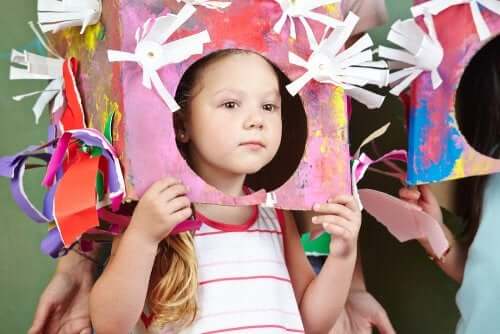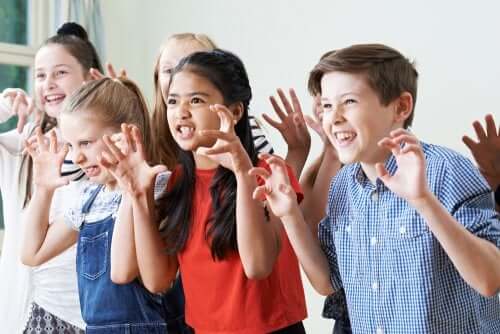Theater in the Classroom: Benefits for Kids

Theater in the classroom is one of the most valuable resources for helping realize your children’s overall education. It’s also a way to help them learn while having fun.
Incorporating drama activities into the classroom can help children develop a variety of skills. As a result, children will be able to explore a world of expression and creativity.
In his book Children’s Theater in Spain: A Challenge, Fernando Aleman reminds us that children’s theater and drama are often thought of as separate things. Despite this, it’s important to remember that children’s theater is a unique and universal concept.
“Theater in the classroom brings together a variety of specialized skills (depending on the activity), that are developed through the role played by the child.”
Dramatic play is a natural part of most children’s lives before they start school or early childhood education, often taking the form of fantasy games. This allows them to make sense of their own identities by exploring fictional situations with structures that parallel the real world.
“Theatrical activity must begin during childhood education. To kids, theater is a game, and children in this stage must play in order to learn.”
Defining theater in the classroom
When we talk about theater in children’s education, we may be referring to plays in which the children act. But we may also be talking about plays designed and written for children as an audience.
In this article, we’ll be referring to theater as brought to life by children. Kids can take initiative in deciding on the play they want to perform, with their teachers providing support throughout the process.

Spanish novelist and screenwriter Armonía Rodríguez Lázaro reminds us that theater as performed by children must always adhere to the following characteristics:
- It should be performed in the children’s classroom.
- All the children should participate in the play.
- The child is the actor and protagonist.
- Improvisation serves as the basis for the activity.
- The teacher should guide the students while encouraging their creativity.
- The game-like quality of theater is fundamental to the child’s free expression.
- The texts should be non-theatrical.
- Music, dance and visual art serve as important complementary elements to the creation of the work.
Developing skills
Children love to move and interact with others. Theater encourages them to do exactly that. They won’t just be sitting quietly and listening. Performing theater will allow them to move and talk to each other.
These dramatic activities help kids develop fundamental skills like creativity, research, communication, empathy, self-esteem, cooperation, leadership, and negotiation.
“The most important thing in all of this is that the theater activities are always fun. This will make learning a pleasant experience that will be remembered forever.”
Learning through theater
In the classroom, theater can be a powerful tool in many different subjects. Specifically, theater helps children develop skills like early reading and writing.
It also promotes oral expression, listening, and expands their vocabularies. In addition, it encourages children to understand and express different points of view.

Through theater, children learn to express their emotions in an environment created especially for it. They begin to explore their cultural values and those of their classmates, which fosters understanding.
It’s an activity that allows kids to think and act creatively. It can also help develop problem-solving skills that can be applied in all areas of learning. What’s more, they’re encouraged to take responsibility and make decisions.
Teachers can take a more open approach in classrooms by focusing on the learning process as well as the goal.
Through theatrical activities, kids have the chance to take an active role in learning, which can carry forward as their education continues. In addition, structured dramatic play is a wonderful tool for their development.
Theater in the classroom is one of the most valuable resources for helping realize your children’s overall education. It’s also a way to help them learn while having fun.
Incorporating drama activities into the classroom can help children develop a variety of skills. As a result, children will be able to explore a world of expression and creativity.
In his book Children’s Theater in Spain: A Challenge, Fernando Aleman reminds us that children’s theater and drama are often thought of as separate things. Despite this, it’s important to remember that children’s theater is a unique and universal concept.
“Theater in the classroom brings together a variety of specialized skills (depending on the activity), that are developed through the role played by the child.”
Dramatic play is a natural part of most children’s lives before they start school or early childhood education, often taking the form of fantasy games. This allows them to make sense of their own identities by exploring fictional situations with structures that parallel the real world.
“Theatrical activity must begin during childhood education. To kids, theater is a game, and children in this stage must play in order to learn.”
Defining theater in the classroom
When we talk about theater in children’s education, we may be referring to plays in which the children act. But we may also be talking about plays designed and written for children as an audience.
In this article, we’ll be referring to theater as brought to life by children. Kids can take initiative in deciding on the play they want to perform, with their teachers providing support throughout the process.

Spanish novelist and screenwriter Armonía Rodríguez Lázaro reminds us that theater as performed by children must always adhere to the following characteristics:
- It should be performed in the children’s classroom.
- All the children should participate in the play.
- The child is the actor and protagonist.
- Improvisation serves as the basis for the activity.
- The teacher should guide the students while encouraging their creativity.
- The game-like quality of theater is fundamental to the child’s free expression.
- The texts should be non-theatrical.
- Music, dance and visual art serve as important complementary elements to the creation of the work.
Developing skills
Children love to move and interact with others. Theater encourages them to do exactly that. They won’t just be sitting quietly and listening. Performing theater will allow them to move and talk to each other.
These dramatic activities help kids develop fundamental skills like creativity, research, communication, empathy, self-esteem, cooperation, leadership, and negotiation.
“The most important thing in all of this is that the theater activities are always fun. This will make learning a pleasant experience that will be remembered forever.”
Learning through theater
In the classroom, theater can be a powerful tool in many different subjects. Specifically, theater helps children develop skills like early reading and writing.
It also promotes oral expression, listening, and expands their vocabularies. In addition, it encourages children to understand and express different points of view.

Through theater, children learn to express their emotions in an environment created especially for it. They begin to explore their cultural values and those of their classmates, which fosters understanding.
It’s an activity that allows kids to think and act creatively. It can also help develop problem-solving skills that can be applied in all areas of learning. What’s more, they’re encouraged to take responsibility and make decisions.
Teachers can take a more open approach in classrooms by focusing on the learning process as well as the goal.
Through theatrical activities, kids have the chance to take an active role in learning, which can carry forward as their education continues. In addition, structured dramatic play is a wonderful tool for their development.
All cited sources were thoroughly reviewed by our team to ensure their quality, reliability, currency, and validity. The bibliography of this article was considered reliable and of academic or scientific accuracy.
- Daste C.; Jenger, Y. y Voluzan, J. (1978). El niño, el teatro y la escuela. Madrid: Villalar.
- Eines, J. y Mantovani, A. (1997). Didáctica de la Dramatización. Barcelona: Gedisa.
- Navarro Solano, M. (2007). Drama, creatividad y aprendizaje vivencial: algunas aportaciones del drama a la educación emocional. Cuestiones pedagógicas, 18, 163-174. https://idus.us.es/xmlui/bitstream/handle/11441/12845/file_1.pdf?sequence=1
- Núñez Cubero, L. y Romero, C. (2004). La educación emocional a través del lenguaje dramático. Addenda a la II Ponencia: Los lenguajes de las Artes. Escenas y Escenarios en Educación, XXII-Site-Sitges Conference.
- Núñez Cubero, L.; Bisquerra Alzina, R.; González Monteagudo, J. y Gutiérrez Moar, M.C. (2006). Emociones y educación: una perspectiva pedagógica. En J.M. Asensio; J. Carrasco García; L. Núñez Cubero y J. Larrosa (Coords.) La vida emocional. Las emociones y la formación de la identidad humana (171-196). Barcelona: Ariel.
- Tejerina, I. (1994). Dramatización y teatro infantil. Dimensiones psicopedagógicas y expresivas. Madrid: Siglo XXI.
This text is provided for informational purposes only and does not replace consultation with a professional. If in doubt, consult your specialist.








